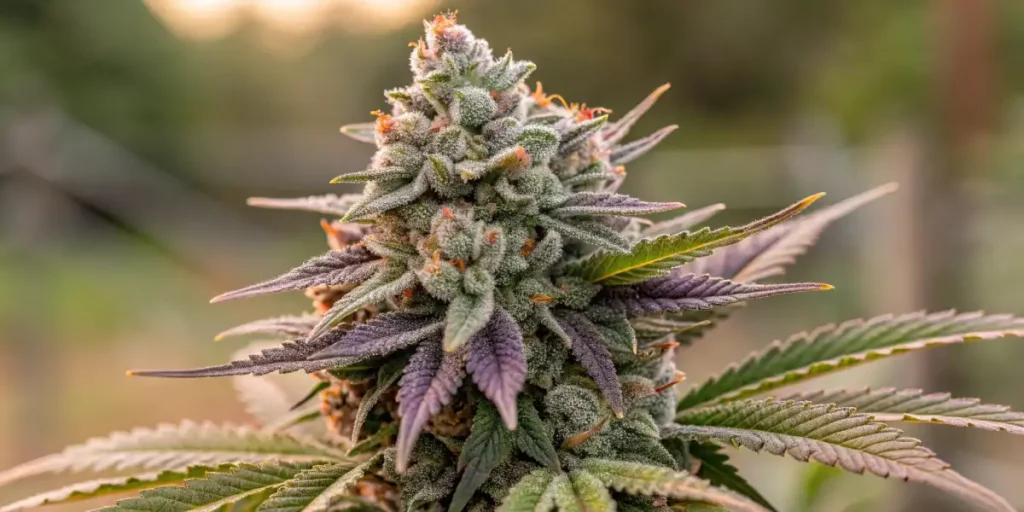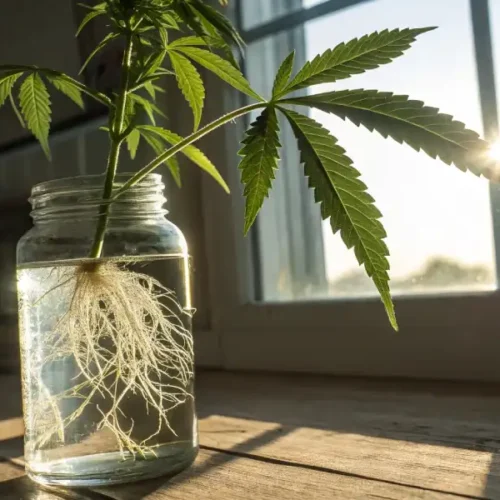Power Plant Weed Strain Description
Power Plant Strain is a popular choice among cannabis growers and enthusiasts. Known for its high THC content and large yields, this strain offers a potent experience for both recreational and medicinal users. Power Plant is a predominantly Sativa strain, with origins traced back to South African genetics. It is celebrated for its fast-growing nature and abundant harvests.
The buds of Power Plant Weed Strain are dense and coated with trichomes, offering a striking appearance. Its aroma is pungent, with earthy undertones combined with subtle hints of spice and sweetness. The flavor profile is equally appealing, delivering a smooth smoke with herbal, peppery notes that linger pleasantly.
Recommended Strains
Power Plant
 THC: 13 - 21%
THC: 13 - 21% Type of seed: Feminized
Type of seed: Feminized Phenotype: Mostly Sativa
Phenotype: Mostly Sativa Day to flower: 8 - 10 weeks
Day to flower: 8 - 10 weeks
Power Plant Weed Seeds typically features THC levels ranging between 15% and 20%, making it a potent option for those seeking a strong cerebral high. The effects are known to be uplifting and energetic, which is why it’s often recommended for daytime use. With proper care, Power Plant produces generous yields, making it a favorite among cultivators looking for both quantity and quality in their crops.
Promos & Deals
Environmental Requirements for Growing Power Plant Weed Strain
Creating an optimal environment is key to maximizing the growth potential of Power Plant Weed Strain. It thrives in both indoor and outdoor settings, although controlling the climate indoors offers more consistent results. Power Plant prefers a temperate climate with daytime temperatures ranging between 70-80°F (21-27°C) and cooler nights.
Indoors, the use of LED or HPS grow lights ensures proper light distribution, with an 18-20 hour light cycle during the vegetative stage. This strain responds well to high-intensity light, making it crucial to use quality equipment. During the flowering stage, a 12-hour light and 12-hour dark cycle will help induce bud development. Outdoor growers should place the plants in areas that receive ample sunlight and protect them from extreme weather conditions.
Humidity control is essential to avoid issues like mold, particularly during the flowering phase when the buds become dense. Aim for 50-60% humidity during the vegetative stage and drop it to 40-50% in flowering. Whether indoors or outdoors, ensure proper ventilation to keep fresh air circulating around the plants. This is especially important for strain power plants, as it helps to prevent moisture buildup and keeps the plants healthy.
Setting Up The Growing Cannabis Space
Indoor Cannabis Cultivation
Indoor cultivation of Power Plant Weed Strain requires a well-prepared space. A grow tent is an excellent option for beginners and seasoned growers alike, as it allows for controlled conditions. Reflective materials inside the tent help to maximize light efficiency, while a ventilation system is necessary to maintain airflow and control humidity. Use an exhaust fan with a carbon filter to manage the strong aroma during the flowering phase.
Choosing a proper growing medium is another important step. Power Plant can thrive in both soil and hydroponic setups, depending on your preference. If using soil, make sure it’s rich in organic material and has good drainage. Hydroponic systems allow for faster growth but require more precise nutrient management. Maintain a pH level of around 6.0 to 6.5 for optimal nutrient absorption.
Outdoor Cannabis Cultivation
Power Plant Weed Strain also performs well outdoors, provided it is grown in a suitable climate. Choose a location that receives at least 6 hours of direct sunlight per day. The soil should be well-draining and rich in organic matter. You can enhance soil quality by adding compost or organic fertilizers.
Consider using large fabric pots to ensure proper root development and allow for easy movement if weather conditions change. Outdoor growers should be mindful of strong winds, which can damage branches. Using stakes or a trellis will help support the plants as they grow and prevent branches from breaking under the weight of heavy buds. Regular pruning will improve air circulation and allow the plant to focus energy on bud production.

Propagation and Germination of Power Plant Weed Strain
Germination is the first step in ensuring a successful Power Plant grow. Start by selecting high-quality Power Plant feminized seeds from a reputable seed bank. This will help ensure genetic stability and avoid issues related to male plants in your garden. Begin germination by soaking the seeds in water or placing them between damp paper towels for 24 to 48 hours.
Once the seeds have developed taproots, transfer them to a growing medium such as seedling trays filled with a light, well-draining soil mix. Keep the environment warm, with a temperature of around 75-80°F (24-27°C), and maintain high humidity levels of 60-70% to promote successful germination. Providing gentle airflow is also important to prevent mold and fungus from developing on the young seedlings.
As the seedlings sprout and develop their first few leaves, ensure they receive sufficient light. If growing indoors, begin with low light intensity and gradually increase it as the plants grow stronger. Outdoors, protect the seedlings from direct sunlight until they become more established. Proper germination techniques will lead to healthy, vigorous plants that can thrive throughout the growing cycle.
Vegetative Phase of Power Plant Strain
During the vegetative phase, Power Plant Weed Strain requires consistent care to promote rapid and healthy growth. This phase is characterized by vigorous leaf and stem development, as the plant prepares for the flowering stage. Providing 18-20 hours of light per day during this stage will help the plant grow tall and strong. High-quality LED or HPS lights are recommended for indoor growers, as these provide the necessary intensity for optimal growth.
Power Plant is a fast-growing strain, so expect significant vertical growth during the vegetative phase. Consider using training techniques such as low-stress training (LST) or topping to manage the height and shape of your plants. These methods help create an even canopy, which allows for better light penetration and ultimately improves bud development.
During this phase, the plant requires more nitrogen to fuel its growth. Use a nutrient solution with a higher nitrogen content to support leaf and stem development. Watering should be done when the top layer of soil is dry to the touch, but be careful not to overwater, as this can lead to root rot. Pruning the lower leaves and branches that don’t receive much light will improve airflow and prevent moisture buildup, reducing the risk of mold.
Flowering Phase of Power Plant Weed Strain
The flowering phase is when Power Plant Weed Strain begins to develop its dense, resin-coated buds. Transitioning the light cycle to 12 hours of light and 12 hours of darkness will trigger the plant to begin flowering. During this phase, the plant will shift its energy from growing stems and leaves to producing buds. The flowering period for Power Plant typically lasts 8 to 10 weeks, depending on environmental conditions.
To support bud development, switch to a nutrient solution higher in phosphorus and potassium while reducing nitrogen. This will help the plant produce larger, more potent buds. Keep the temperature slightly cooler during flowering, around 65-75°F (18-24°C), and reduce humidity to 40-50% to prevent mold or mildew from affecting the dense buds.
As the buds grow, the branches may become weighed down by their own weight. Supporting the branches with stakes or a trellis will prevent them from breaking and ensure the plant can focus on producing high-quality buds. Power Plant Strain is known for its high yields, making this an exciting time for growers as they prepare for harvest.
Cannabis Fertilization and Nutrition
Proper nutrition is essential to maximize the potential of Power Plant Weed Strain. During the vegetative phase, focus on providing a nutrient solution rich in nitrogen. As the plant transitions to flowering, switch to a bloom formula higher in phosphorus and potassium. This shift in nutrients will support bud development and enhance the quality of your harvest.
Additionally, consider using supplements such as mycorrhizae to promote root health, or bloom boosters to enhance bud production. Keep an eye on your plants for signs of nutrient deficiencies, such as yellowing leaves or stunted growth, and adjust your feeding schedule accordingly. Flushing the plants with plain water during the last two weeks of the flowering phase helps to remove excess nutrients and improves the flavor of the final product.
Pest And Disease Control for Cannabis Growing
Like many cannabis strains, Power Plant Weed Seeds can be susceptible to pests and diseases, especially during the flowering phase. Common pests include spider mites, aphids, and thrips. Regularly inspect your plants for any signs of infestation and address issues early to prevent them from spreading.
Maintaining a clean growing space, proper ventilation, and healthy plants are the best ways to prevent pest issues. Introducing beneficial insects like ladybugs or predatory mites can help keep pest populations in check. If you detect pests, organic solutions such as neem oil or insecticidal soap can be used to control infestations without harming your plants.
Mold and mildew are also concerns during the flowering stage, especially if humidity levels are too high. Reducing humidity and improving airflow around the plants will help prevent mold from developing. Keeping the growing area clean and free of debris is also important to prevent diseases from taking hold. Pruning lower branches and leaves can improve airflow, further reducing the risk of mold and mildew during the flowering phase.
Harvesting and Curing for Cannabis Growing
Harvesting Power Plant Weed Strain at the right time is crucial for maximizing potency, flavor, and yield. To determine when your plants are ready for harvest, examine the trichomes on the buds. Using a magnifying tool, look for trichomes that have turned cloudy or amber in color, which indicates the peak THC content. Harvesting too early may result in lower potency, while waiting too long can degrade the THC into less desirable compounds.
When the buds are ready, use sterilized shears to cut the branches. Remove any large fan leaves but leave the smaller sugar leaves intact. Hang the branches upside down in a dark, well-ventilated space to dry. Maintaining a temperature of 60-70°F (15-21°C) and a humidity level of 50-60% will allow the buds to dry slowly, preserving their terpenes and cannabinoids.
Drying typically takes between 7-14 days. Once the buds feel dry to the touch, they are ready to be trimmed and placed into glass jars for curing. The curing process involves sealing the jars and opening them daily for the first week to allow moisture to escape. After that, the jars can be opened every few days. Curing can last anywhere from 2 to 4 weeks or longer, depending on personal preference, and it greatly improves the flavor and smoothness of the final product.

Is Power Plant Weed Strain Indica or Sativa?
Power Plant Weed Strain is predominantly Sativa, known for its energetic and uplifting effects. It originated from South African Sativa landraces, and as such, it carries many of the typical Sativa traits, including a high that stimulates creativity and focus. Unlike Indica strains, which are more sedative and relaxing, Power Plant offers a cerebral high, making it ideal for daytime use. However, some users may experience a mild body relaxation, especially when consumed in higher doses.
This strain’s Sativa dominance is reflected in its growth pattern as well. Power Plant tends to grow tall and lanky, with long, thin leaves characteristic of Sativa strains. The flowering time is relatively short for a Sativa, usually taking around 8-10 weeks to fully develop, which is another reason it’s favored by growers who want quick results without sacrificing yield.
Advantages of Growing Power Plant Weed Strain
Power Plant Weed Strain offers several advantages for both beginner and experienced growers:
- Fast flowering time for a Sativa-dominant strain.
- High yields of dense, resinous buds.
- Strong resistance to pests and diseases.
- Highly potent with THC levels up to 20%.
- Energetic and uplifting effects, ideal for daytime use.
- Adaptable to indoor and outdoor growing environments.
Disadvantages of Growing Power Plant Strain
- May require support due to the heavy weight of buds.
- Strong odor during flowering, requiring odor control measures.
- Sensitive to high humidity, increasing the risk of mold.
- Tall growth may be challenging in smaller indoor setups.
Why Buy Power Plant Weed Strain
There are many reasons to choose Power Plant Kush Strain for your next cannabis grow:
1. Potent Effects: With THC levels ranging from 15% to 20%, Power Plant provides a powerful and uplifting experience, perfect for users seeking a stimulating cerebral high.
2. High Yields: This strain is known for its generous yields, making it a great choice for growers looking to maximize their harvest.
3. Versatile Growing Conditions: Power Plant performs well in both indoor and outdoor environments, making it a flexible option for various climates and grow setups.
4. Fast Flowering Time: For a Sativa-dominant strain, Power Plant has a relatively short flowering time of 8-10 weeks, allowing for quicker turnaround compared to other Sativas.
5. Uplifting Effects: The energetic and creative high makes Power Plant ideal for social settings or when you need a mental boost during the day.
Common Problems in Cultivating Power Plant Weed Strain
While Power Plant Weed Strain is generally a resilient and easy-to-grow strain, there are some common issues that growers might face:
1. Mold and Mildew: Due to the dense structure of the buds, Power Plant can be susceptible to mold if humidity levels are too high during the flowering phase. Keep humidity under control and ensure proper airflow to avoid these issues.
2. Height Management: As a tall-growing Sativa, Power Plant may outgrow indoor spaces if not properly trained. Techniques like topping or low-stress training (LST) can help keep the plant’s height manageable.
3. Odor Control: The pungent aroma of Power Plant during flowering can be overwhelming, especially for indoor growers. Using carbon filters and other odor control methods is essential to avoid attracting unwanted attention.
4. Nutrient Sensitivity: Like many Sativa strains, Power Plant can be sensitive to nutrient imbalances, particularly nitrogen. Monitor your feeding schedule closely to prevent nutrient burn or deficiencies.
Similar Strains to Power Plant Weed Strain
If you enjoy growing or consuming Power Plant Weed Strain, you may also like these similar strains:
Durban Poison: is another Sativa strain with South African origins. It shares similar uplifting and energizing effects, making it a favorite for daytime use. Like Power Plant, Durban Poison has a fast flowering time and is resistant to pests, making it a good choice for growers.
Sour Diesel: is a popular Sativa strain known for its energizing effects and strong, pungent aroma. While it has a slightly longer flowering time than Power Plant, it delivers similarly high THC levels and is often used by those seeking an invigorating mental boost.
Green Crack: is a potent Sativa that offers an intense burst of energy and focus. It has a similar flavor profile to Power Plant, with citrus and earthy undertones. This strain is also easy to grow and known for its quick flowering time and high yields.
Tips for Professional Growers
Professional growers looking to maximize their yields and quality when cultivating Power Plant Weed Strain should consider the following tips:
1. Implement Advanced Training Techniques: Techniques like Screen of Green (ScrOG) or high-stress training (HST) can help create a more even canopy and increase yields. Power Plant responds well to these techniques, especially in indoor grows.
2. Use High-Quality Nutrients: While Power Plant is generally forgiving, using high-quality nutrients tailored to each growth stage can significantly improve your results. Consider using organic or specialized cannabis nutrients to boost terpene production.
3. Maintain Optimal Lighting: Power Plant thrives under high-intensity lights. Professional growers should use high-quality LED or HPS lights and maintain the appropriate distance from the canopy to maximize light absorption without causing light burn.
4. Monitor Environmental Conditions Closely: Power Plant is sensitive to humidity and temperature fluctuations, especially during the flowering phase. Use environmental controls like dehumidifiers and fans to maintain stable growing conditions.
5. Prune Regularly: Regular pruning during the vegetative phase ensures that light penetrates all parts of the plant. Removing unnecessary foliage also improves airflow, reducing the risk of mold or pest infestations.
FAQs about Power Plant Weed Strain
How long does it take for Power Plant Weed Strain to flower?
Power Plant typically has a flowering time of 8-10 weeks, which is relatively short for a Sativa-dominant strain.
What is the THC content of Power Plant Weed Strain?
The THC levels in Power Plant Weed Strain range between 15% and 20%, depending on growing conditions and phenotype.
Can I grow Power Plant indoors?
Yes, Power Plant can be successfully grown indoors. Just make sure to manage its height with training techniques like topping or LST and maintain proper lighting conditions.
Is Power Plant suitable for beginners?
Power Plant Weed Strain is considered beginner-friendly due to its resilience and relatively easy cultivation process. However, it does require some attention to humidity and height management.
What are the effects of Power Plant Weed Strain?
Power Plant Weed Strain provides uplifting and energetic effects, making it a great option for daytime use. It promotes creativity and focus, with mild relaxation in the body, especially when consumed in higher doses.

















